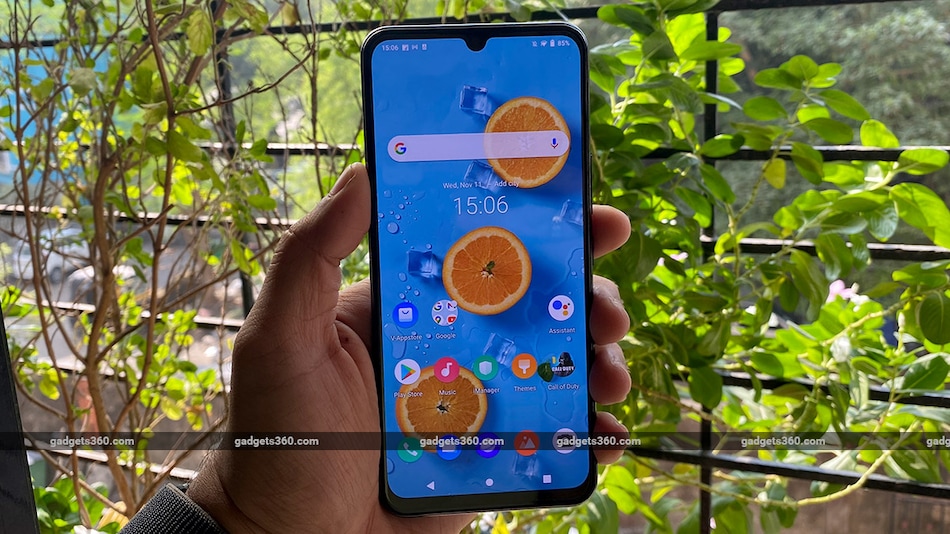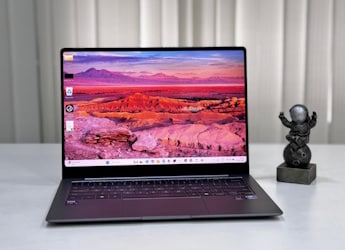- Home
- Mobiles
- Mobiles Reviews
- Vivo V20 SE Review
Vivo V20 SE Review
Vivo V20 SE is priced at Rs. 20,990 in India

The Vivo V20 SE sports a 32-megapixel selfie camera
Vivo V20 SE is the latest addition to the Vivo's V-series, and it is positioned as a more affordable version of the Vivo V20, which was launched last month. With the V20, Vivo focused on design and cameras, and you can see a similar approach with the Vivo V20 SE as well. However, to target a lower price point, the V20 SE has undergone a cost-cutting exercise resulting in lower resolution camera sensors and a different processor, among other things. So is the Vivo V20 SE still special, or has Vivo gone a bit too far? Let's find out.
Vivo V20 SE design
Vivo claims that the focus was on design for the Vivo V20 SE, and that is evident. The smartphone is thin and the weight is easily manageable. Vivo has gone with a 6.44-inch AMOLED display just like on the Vivo V20 (Review), with a dewdrop notch at the top and thin borders surrounding it. You get a full-HD+ resolution with a 20:9 aspect ratio, which means the display is tall and narrow.
The sides of the smartphone are rounded, which makes it comfortable to hold. The frame of the V20 SE is made out of plastic and all the buttons are on the right. I found the power and the volume buttons to be easy to reach. They also had a clicky feedback, so I didn't have to second-guess a button press.
![]()
The V20 SE has an AMOLED display and an in-display fingerprint sensor
The left side of the V20 SE is bare, as Vivo has positioned the SIM tray at the top. You get dual Nano-SIM slots along with a dedicated microSD card slot which makes storage expansion possible. The top and the bottom of the V20 SE are flat. There's a USB Type-C port, a 3.5mm headphone jack, a speaker, and a microphone at the bottom.
Turning the phone around reveals the triple camera setup of the V20 SE. The camera module sits in the top left corner and is slightly raised. Vivo offers two colour options, Aquamarine Green and Gravity Black. I had the latter for this review, and I found the glossy finish at the back prone to fingerprints and smudges. I used the supplied case to avoid wiping the smartphone frequently. Vivo also includes a 33W FlashCharge charger in the box, which should top up the 4,100mAh battery quickly.
Vivo V20 SE specifications
While Vivo calls this a Special Edition (SE) the specifications are watered down compared to the Vivo V20. Powering the V20 SE is the Qualcomm Snapdragon 665 SoC, paired with 8GB of RAM and 128GB of storage. There is only one configuration of the V20 SE on sale in India, and it is priced at Rs. 20,990. While you do get decent amounts of RAM and storage, the processor isn't very powerful considering the price. You will find the exact same processor in much more affordable smartphones such as the Realme Narzo 20A and the Nokia 5.3 (Review).
The V20 SE sports a 6.44-inch AMOLED display with an in-display fingerprint scanner just like the Vivo V20. The display has good viewing angles and gets bright enough when outdoors. You also get the option to tweak the colour profile and temperature of the panel.
![]()
The V20 SE runs Funtouch OS 11 on top of Android 10
Unlike the Vivo V20, the V20 SE does not run Android 11 out of the box – you get Android 10 instead. It still has the new FunTouch OS 11 UI on top, and Vivo is promising to roll out a software update to Android 11 soon. My unit was running the September Android security patch, which is fairly recent. The UI looks a lot like what you get on the V20 and there is some preinstalled bloatware. I found Facebook, Flipkart, PhonePe, Snapchat, and Spotify on my device. Vivo also has its own V-Appstore which is an alternative to the Google Play Store. There's also a Themes app, which lets you customise the UI right down to the fonts.
The V20 SE lets you customise the charging and unlock animations. You can also take advantage of the AMOLED panel and enable an always-on display mode. There is an Ultra game mode which lets you mute incoming calls and notifications while you are playing games, similar to what I've seen on Vivo smartphones I've tested in the past.
Vivo V20 SE performance
The V20 SE is capable of delivering acceptable performance without any issues. While using the smartphone, I did not notice lag, and multitasking was a breeze thanks to the 8GB of RAM. The in-display fingerprint scanner as well as face recognition were quick to unlock the Vivo V20 SE. Casual usage was good enough, but the slow processor does seem to increase app loading times.
I ran a few benchmark tests to see where the Vivo V20 SE stands. In AnTuTu, the V20 SE managed 1,84,085, which is lower than what competitors at the same price level can manage, for example the Poco X3 (Review), which scored 2,80,030. The V20 SE scored 6,364 in PCMark Work 2.0 andmanaged 315 and 1,389 points respectively in Geekbench's single-core and multi-core tests. In the graphics benchmark test GFXBench's T-Rex and Car Chase scenes, the V20 SE managed 32fps and 6.2fps.
![]()
The glossy back of the Vivo V20 SE is a fingerprint magnet
Performance was noticeably lower while playing heavy titles such as Call of Duty: Mobile. I noticed longer load times than usual, and the game ran with the graphics quality and frame rate set to Medium by default. After playing the game for 20 minutes, I noticed a six percent drop in the battery level. The Vivo V20 SE did not have any issues running casual games such as Among Us.
Battery life on the V20 SE is decent, and the phone went on for a day and a half without me rushing for a charger. In our HD video loop test, the V20 SE went on for 14 hours and 31 minutes which is about the same as what the Vivo V20 managed. Charging was quick with the 33W charger bundled in the box. The device got to 52 percent in 30 minutes and about 96 percent in an hour.
Vivo V20 SE cameras
The Vivo V20 SE packs a triple camera setup at the back consisting of a 48-megapixel primary camera, an 8-megapixel ultra-wide-angle camera that is also capable of macro photography, and a 2-megapixel “bokeh camera”. The camera app feels similar and is super easy to use. AI is enabled by default and the phone is quick to determine what it's pointed towards. It also suggested different shooting modes and cameras based on the scene. Vivo has added an AI Image Matting feature in the album app which lets you edit photos to change the sky, add a moving effect, or even remove objects.
Vivo V20 SE daylight camera sample (tap to see full-size image)
Vivo V20 SE daylight ultra-wide-angle camera sample (tap to see full-size image)
In daylight, the Vivo V20 SE managed decent shots with good details on objects even at a distance. While shooting outdoors in bright conditions, the V20 SE is quick to enable HDR. Switching to the ultra-wide-angle camera offers a wider field of view but at the cost of details. Objects at a distance weren't as crisp as they appeared in photos taken with the primary camera. There was visible distortion at the edges as well. You can take photos at the full 48-megapixel resolution but the level of detail is not as good as in shots taken at the default 12-megapixel binned resolution.
Vivo V20 SE close-up camera sample (tap to see full-size image)
Vivo V20 SE macro camera sample (tap to see full-size image)
Closeups turned out really well, and the phone managed to capture sharp images. It also adds a soft depth effect to the background. Portrait shots with steady subjects turned out well, with good edge detection. The V20 SE uses its ultra-wide-angle camera for macro shots and lets you get super close to a subject. I like this approach, since you get good functionality without needing another sensor, and shots have a higher resolution.
Vivo V20 SE low light camera sample (tap to see full-size image)
Vivo V20 SE Night Mode camera sample (tap to see full-size image)
Low-light camera performance is average overall. The V20 SE managed to keep noise under control but photos appeared smoothened and objects at a distance had a watercolour-like effect. Enabling Night Mode resulted in slightly brighter images with better detail, but it took about 3-4 seconds to process each shot.
Vivo V20 SE daylight portrait selfie sample (tap to see resized image)
Vivo V20 SE low light selfie sample (tap to see resized image)
The V20 SE managed good selfies in daylight as well as low light. You can take portrait shots using the selfie camera, and the V20 SE blurs out the background automatically. Beautification is enabled by default, which smoothens the output. In low light, you can use a screen flash, which Vivo calls Aura Screen Light, and this does help capture brighter images.
Video recording tops out at 4K for the primary camera and 1080p for the selfie shooter. Footage shot at 1080p in daylight was stabilised but not footage shot at 4K. In low light there was a slight shimmer in the footage shot at 1080p, while 4K footage wasn't stabilised.
Verdict
The Vivo V20 SE should have been called the V20 Lite, considering that Vivo has watered down the specifications quite a lot to target a lower price point. Just like the Vivo V20, this phone focuses on design and cameras, so if you are looking for decent camera performance at around the Rs. 20,000 price point, the Vivo V20 SE can offer you that. On the other hand, if you are looking for a well-rounded smartphone, the V20 SE isn't your best bet. It sports a weaker processor, which is evident when playing heavy games. In this case, the Realme 7 Pro (Review) and the Poco X3 (Review) would be suitable alternatives.
Get your daily dose of tech news, reviews, and insights, in under 80 characters on Gadgets 360 Turbo. Connect with fellow tech lovers on our Forum. Follow us on X, Facebook, WhatsApp, Threads and Google News for instant updates. Catch all the action on our YouTube channel.
- Samsung Galaxy Unpacked 2025
- ChatGPT
- Redmi Note 14 Pro+
- iPhone 16
- Apple Vision Pro
- Oneplus 12
- OnePlus Nord CE 3 Lite 5G
- iPhone 13
- Xiaomi 14 Pro
- Oppo Find N3
- Tecno Spark Go (2023)
- Realme V30
- Best Phones Under 25000
- Samsung Galaxy S24 Series
- Cryptocurrency
- iQoo 12
- Samsung Galaxy S24 Ultra
- Giottus
- Samsung Galaxy Z Flip 5
- Apple 'Scary Fast'
- Housefull 5
- GoPro Hero 12 Black Review
- Invincible Season 2
- JioGlass
- HD Ready TV
- Laptop Under 50000
- Smartwatch Under 10000
- Latest Mobile Phones
- Compare Phones
- Huawei Nova 15
- Huawei Nova 15 Pro
- Huawei Nova 15 Ultra
- OnePlus 15R
- Realme Narzo 90x 5G
- Realme Narzo 90 5G
- Vivo S50 Pro Mini
- Vivo S50
- Asus ProArt P16
- MacBook Pro 14-inch (M5, 2025)
- Huawei MatePad 11.5 (2026)
- OnePlus Pad Go 2 (5G)
- OnePlus Watch Lite
- Just Corseca Skywatch Pro
- Acerpure Nitro Z Series 100-inch QLED TV
- Samsung 43 Inch LED Ultra HD (4K) Smart TV (UA43UE81AFULXL)
- Asus ROG Ally
- Nintendo Switch Lite
- Haier 1.6 Ton 5 Star Inverter Split AC (HSU19G-MZAID5BN-INV)
- Haier 1.6 Ton 5 Star Inverter Split AC (HSU19G-MZAIM5BN-INV)













